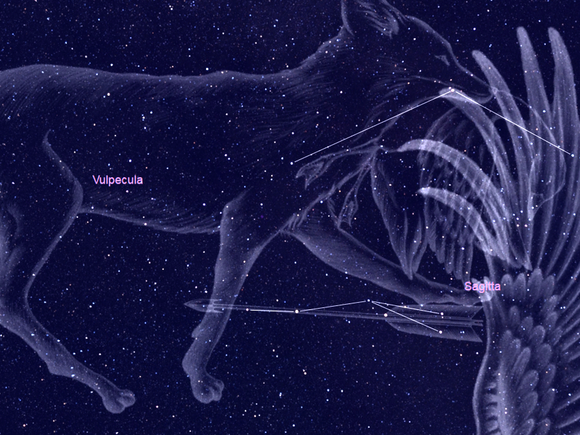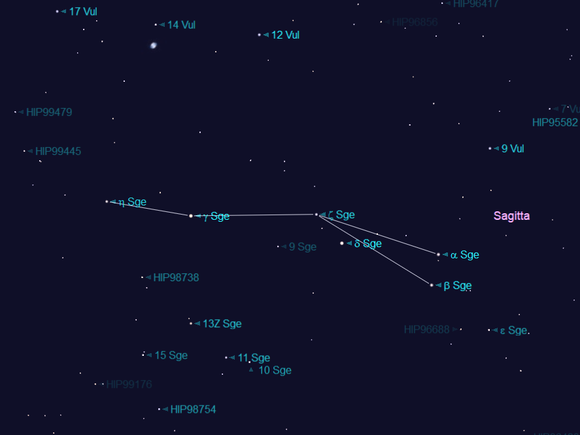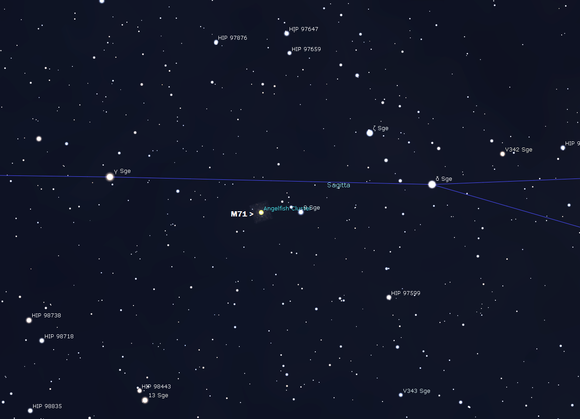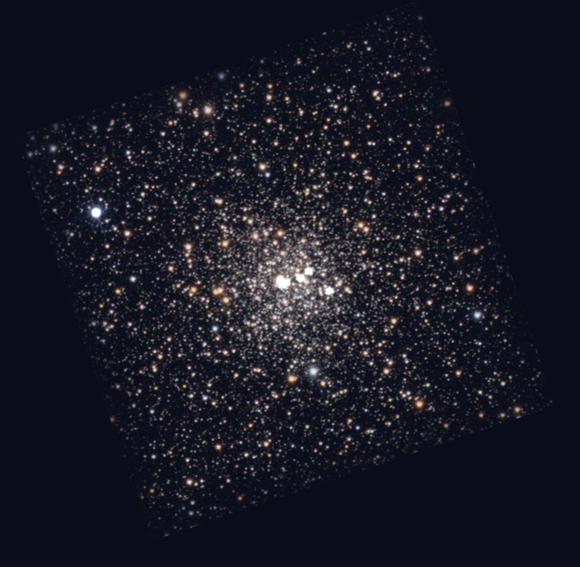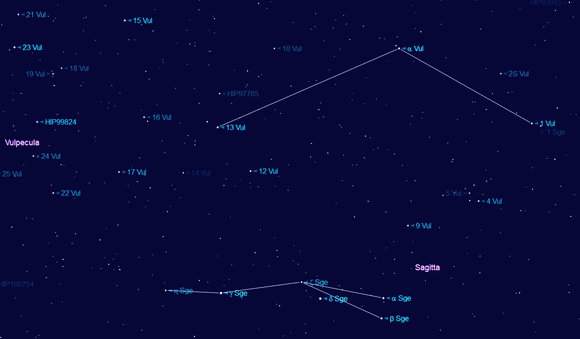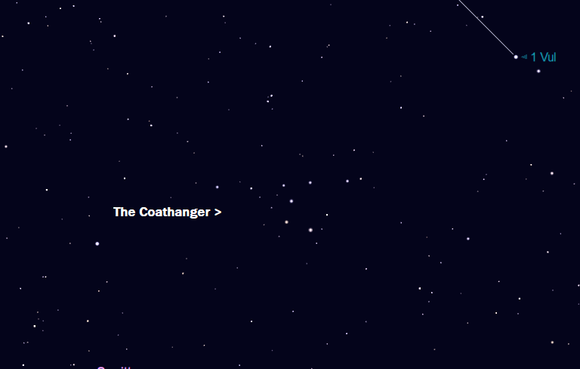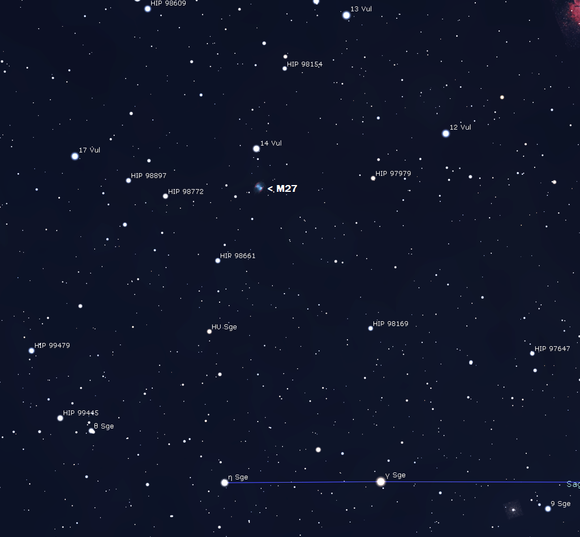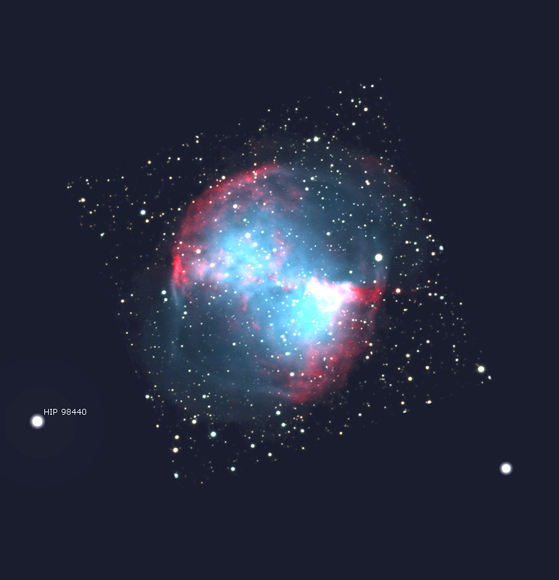Sagitta - the Arrow was well-known to the Greeks and was among the 48 constellations listed by Ptolemy in the Almagest. It is ranked 86th in size (third-smallest constellation in the sky) and has no stars brighter than fourth magnitude. Its outline is however distinctive, an arrow shape and it contains one Messier object.
There are a number of different stories in mythology accounting for the arrow. Germanicus Caesar identified Sagitta as an arrow of Eros, which struck Zeus and kindled his passion for Ganymede, a shepherd boy (now associated as Aquarius). It was told that the arrow was guarded in the sky by the eagle of Zeus and Sagitta does indeed lie next to the constellation of Aquila the eagle. According to Hyginus however, the arrow was shot by Heracles (Hercules) to kill the eagle that was eating the liver of Prometheus. He had been chained to up as punishment by Zeus for the theft of 'fire', which he carried in a beansheaf. The liver of Prometheus would regenerate overnight, only for the eagle to resume his feast in the morning. In yet another tale, Eratosthenes described it as the arrow with which Apollo killed the Cyclopes. According to this tale, Apollo's son Asclepius was a great healer with the power even to raise the dead. Hades; god of the Underworld, complained to his brother, Zeus that his world was depopulating. Zeus struck down Asclepius with a thunderbolt, but in revenge Apollo shot the Cyclops with an arrow, as it was they who made the thunderbolts for Zeus. Asclepius is commemorated by the constellation Ophiuchus in the sky.
Heracles slays the eagle of Zeus feasting on Prometheus.
Painting by Carl Bloch (1834-1890) (click for larger image)
Sagitta has a distinctive outline, but is rather faint and you will struggle to identify it in strong moonlight or light polluted skies. The main stars are:
- γ Gamma Sagittae, the brightest star in Sagitta with an apparent magnitude of +3.51. It is an orange giant star with a stellar classification of K5III and is approximately 640 times more luminous than the Sun and 2.5 times more massive. It resides 276 light years away.
- δ Delta Sagittae is a close multiple star system that has a red giant for the primary component, and a blue-white main sequence star for the secondary component. They orbit each other in 3725 days. The apparent magnitude is 3.68. The star system lies approximately 448 light years distant from the Sun with a real luminosity of 2700 times the Sun.
- α Alpha Sagittae 'Sham' or Alsahm, is derived from the Arabic sahm, which means 'the arrow' and is the only named star in Sagitta, but only the third brightest. With an apparent magnitude of 4.39 it lies 620 light years away being around 350 times more luminous and 20 times the Sun's radius. The star; a yellow giant, has a stellar classification of G1 II.
- β Beta Sagittae is a yellow giant star with the stellar classification G8IIIa. It has an apparent magnitude of 4.387 and is approximately 470 light years distant.
- ζ Zeta Sagittae is a triple star system. The primary component is a white main sequence star of stellar class A3V. The apparent magnitude is 5 and it is 326 light years distant.
- η Eta Sagittae is even fainter at mag 5.1. It is an orange giant of spectral class K2III approximately 162 light years distant.
- ε Epsilon Sagittae is yet another multiple star system. It has an apparent magnitude of 5.67 and is approximately 473 light years distant from the Sun.
- S Sagittae is a Cepheid variable with variations in brightness ranging from 5.5 to 6.2 over a period of 8.38 days. It has a mean apparent magnitude of 5.71 and lies almost 4,300 light years distant.
- U Sagittae is an Algol-type eclipsing variable with a stellar classification of B8III + K. The mean apparent magnitude is 6.50 and it lies 1,000 light years away.
Deep Sky Objects
M71 (NGC 6838) is a globular cluster positioned midway between Delta and Gamma Sagittae, but lying on a line somewhat south of the line joining them. It is some 10 degrees north of Altair in Aquila. The object was initially discovered in 1745/46 by the Swiss amateur astronomer Phillipe Loys de Cheseaux, but its existence was never published in scientific print, only verbally to the Paris Acadamy of Sciences. It was re-discovered in 1775, by Johann Gottfried Kohler in Germany, but as news of this observation took so long to become known in France, in late June of 1780 Pierre Mechain was also credited as the discoverer. Made aware by Mechain, Messier first observed and catalogued M71 later that year. For many decades astronomers were undecided whether M71 was a very old compact galactic cluster, or a loose globular. There was evidence for both cases, but opinion today has swung toward the globular corner.
Orbiting around the galactic centre 18,000 light years from us, M71 takes approximately 160 million years to do one circuit. Its mass of 40,000 Suns is considerably less than most globular clusters, as is its size - just 40 light years across. One reason for this may be down to the clusters orbital eccentricity of just 0.2 which keeps M71 always within the galactic disk plane and undoubtedly frequent encounters with other galactic objects. At magnitude +8 M71 can be glimpsed in 10x50 binoculars as a nebulous spot. Apertures’ of 80mm will start to reveal the brightest stars in the cluster, but as the surrounding field of the Milky Way is also rich, they tend to blend in. Larger apertures’ will reveal a swarm of stars 40 plus in a noticeable triangular formation.
Vulpecula - The Fox
This constellation was introduced in 1687 by the Polish astronomer Johannes Hevelius, who depicted it as a fox, carrying a goose in its jaws. Not sure where the goose is today, maybe it got cooked, but at any rate just the fox remains. Hevelius himself was somewhat inconsistent in his naming of this constellation. In his star catalogue he named the pair ‘Vulpecula cum Ansere’, the fox with goose, but showed them separately in his star atlas.
Vulpecula contains no named stars, its brightest star, Alpha Vulpeculae, the only star within Vulpecula honoured with a Greek letter, is magnitude +4.4. It was allocated by Francis Baily in 1845, who was also the first to shorten the constellation’s name to plain Vulpecula. The faint constellation does redeem itself by the presence of two noteworthy objects, the planetary nebula M27 and the asterism known as the 'Coathanger'. This asterism which lies on the border with Sagiita is also known as Brocchi’s Cluster or Collinder 399 (Cr399). It is popularly known as the Coathanger because of its distinctive bar-and-hook shape. It consists of ten stars of 5th magnitude and fainter and is just visible to the naked eye under good conditions. Cr 399 was regarded as an actual star cluster until the early part of the 21st century, when improved stellar distance measurements showed that most of the stars were a chance alignment and not associated at all. It is a striking one at that, especially when observed at very low powers or with binoculars which really do give the impression of a coathanger.
M27 (NGC 6853) or Dumbbell nebula lies just 3.3 degrees due north of Gamma Sagittae, the brightest star in the arrow nearby Sagitta. It was discovered by Messier in July of 1764 and was the first discovery of such an object although Messier would not know the nature of it. William Herschel was credited with recognising the dumbbell shape, but it was his son John who gave the nebula its popular name. M27 is relatively close as deep sky objects go; approximately 1200 light years away (estimates vary between 1150 and 1350 light years).
With regard to overall brightness M27 has a magnitude of +7.4, only the closer Helix nebula is fractionally brighter, but is of lower surface brightness. Along with M57-the Ring Nebula, M27 is the most studied planetary nebula in the sky. In terms of overall size the Dumbbell is over 5 light years across, although the view that greets the amateur astronomer in the eyepiece is around 3 light years. Images from the HST reveal that the boundary of the inner region is very ragged and full of knots. These lie where the hot ionisation gas pushing outwards from inside meets the cooler doughnut shaped outer envelope. This outer layer is expanding at a rate of 2.3" arc seconds per century, whilst the faster inner region is expanding at 6.8" arc seconds. Planetary nebulae are relatively transient objects and M27 is estimated to be just 9000 years old. It is widely considered the most conspicuous planetary nebula for smaller instruments, and at mag 8 can even be spotted with larger binoculars as an oval 'puff' of light. Three inch (80mm) scopes will start to reveal the hourglass shape, which becomes more conspicuous and detailed as aperture size increases, including revealing several stars within the nebula. From urban or light polluted areas, M27 can be a little tricky to spot, but under dark skies it truly is a splendid sight!
Credits - Sky Charts: Stellarium Software and Starry Night Pro Plus 8 unless otherwise stated.
- Log in to post comments

